This week, I battled alien invaders.
The battleground was Muller, a 5 month old bull terrier puppy. He was really sick, not eating, and had a painful belly and nasty diarrhea. The cause turned out to be a type of intestinal worm called Strongyloides. Where most self-respecting worms spread as eggs passed in stools, waiting for the next unsuspecting host to ingest them, these guys are different: they pass as swimming larvae in the stools and are looking to burrow their way through intact skin – they actively invade their next host. And that next host could be another dog… or a human. You won’t see them coming though; they are tiny, only a couple of millimeters long.
You won’t see them coming though; they are tiny, only a couple of millimeters long.
Now in Muller’s case, he most likely got the worms from his mother. A mother dog that is infected will have the worms traveling through her system. The placenta does not let them through, the puppies will not get the worms before they are born; but then they will nurse and they get the worms from their mother’s milk.
Muller was not sick before this point, though – a well-functioning immune system can keep the infestation down to a “dull roar”. But then, something happens to tip the balance. In Muller’s case, we think this was “Thanksgiving-itis” – he developed a bit of large bowel diarrhea that we suspect had a lot to do with people slipping him goodies from the holiday table. He wasn’t really sick with that, and that minor upset was improving after a couple of days. But then at about the 4th day, he stopped eating and got really depressed. He went from having a minor case of “the squits” to having a profuse, watery foul-smelling stool. The stress to his system of a minor “dietary indiscretion” had give the worms a chance to get the upper hand.
The Cannibal Connection
Muller lost muscle mass really fast! Just not eating is not enough to make muscle tissue disappear – when it comes to scavenging calories, the body is going to use up its fat stores first. But Muller was losing protein, as his denuded intestines oozed out protein-rich fluid that got excreted along with his diarrhea. His blood protein levels were low – and the blood stream needs a certain level of protein to function properly. Desperate to re-build essential blood proteins, the body starts to salvage protein building blocks from its own tissues. Muller was cannibalizing himself!
The Vampire Vulnerability
As scary as free-living squirming worms waiting to burrow into our flesh may be, they are not about to mount any movie-worthy superinvasions. Why? They can’t abide sunlight. UV light, and drying out, will both kill them off. They will only survive in the environment in shady moist areas.
Tough Little Buggers
Now, I had just seen Muller for the last of his puppy vaccines a couple of weeks earlier. I had suggested then that it would be a good idea to check his stools for parasites; however, Muller had already had a course of roundworm dewormer so his human decided to pass on that.
The kicker is that these worms are NOT susceptible to regular roundworm dewormer. They share this dubious honour with several other parasites:
Hookworms (Ancylostoma)
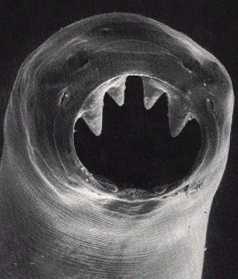 I am pretty sure some Hollywood Special FX Monster producers have looked to these guys for inspiration. They are horrifying. Their cup-shaped heads are one great big mouth, lined by razor-sharp tooth-like plates. They latch on to the intestinal lining, saw at it with their tooth-plates, and suck up the rich body fluids that ooze out.
I am pretty sure some Hollywood Special FX Monster producers have looked to these guys for inspiration. They are horrifying. Their cup-shaped heads are one great big mouth, lined by razor-sharp tooth-like plates. They latch on to the intestinal lining, saw at it with their tooth-plates, and suck up the rich body fluids that ooze out.
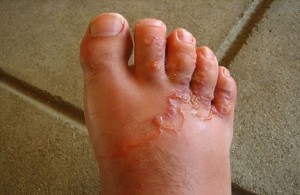 They also share Strongyloides’ ability to penetrate into skin. They are not passed in the stool as larvae, they come out as eggs; but if the stool is left in peace the larvae hatch in a few days. They will burrow into the body parts they come in contact with (for example nice bare feet), and carve out for themselves a nice itchy, inflamed meandering tunnel.
They also share Strongyloides’ ability to penetrate into skin. They are not passed in the stool as larvae, they come out as eggs; but if the stool is left in peace the larvae hatch in a few days. They will burrow into the body parts they come in contact with (for example nice bare feet), and carve out for themselves a nice itchy, inflamed meandering tunnel.
Whipworms (Trichuris)
These get their name from a resemblance to the handle and lash of a whip. A better comparison would be a needle and thread – these guys operate by “sewing” themselves into the intestinal lining, leading with their skinny end. Nestled right in the tissue itself, they are bathed in the host’s nutrients.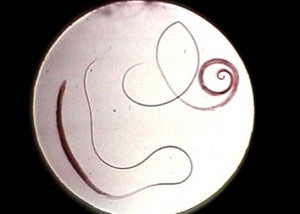
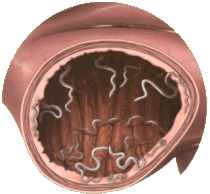
Giardia (Beaver Fever)
The other creepy creatures we have discussed so far are not very common.
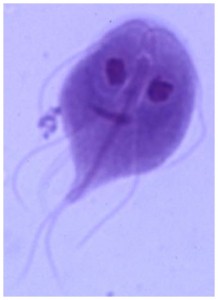 The same can not be said for Giardia – we see LOTS of it in puppies. Giardia is not a worm – it is a protozoal parasite, a little single-celled organism. Its swimming form, called a Trophozoite, is actually pretty comical looking – it looks like a big googly-eyed facemask.
The same can not be said for Giardia – we see LOTS of it in puppies. Giardia is not a worm – it is a protozoal parasite, a little single-celled organism. Its swimming form, called a Trophozoite, is actually pretty comical looking – it looks like a big googly-eyed facemask.
What is does is not so comical. The lining of your intestine can be likened to a lawn of grass-blades. It is covered by little projections called villi that give your intestine lots of surface area for the absorption of nutrients.
These goggly-eyed monsters graze on that lawn like sheep grazing a meadow. These “grass-blades”, though, have a network of blood vessels up their cores – these grass blades bleed when chewed on. The result is a bloody mucoid diarrhea.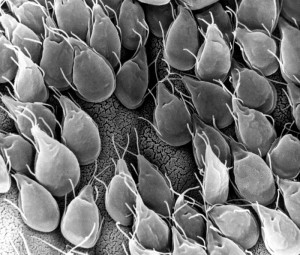
These are another parasite that is not picky about species – they are quite happy to go to people. The name “beaver fever” comes from the fact that humans often get it from drinking water that is home to river animals shedding the parasite. I have had a bout of Giardia myself after a camping trip – it was not fun…

(Dr. Winslow’s eldest) O.O …That is just tragic. And gross.